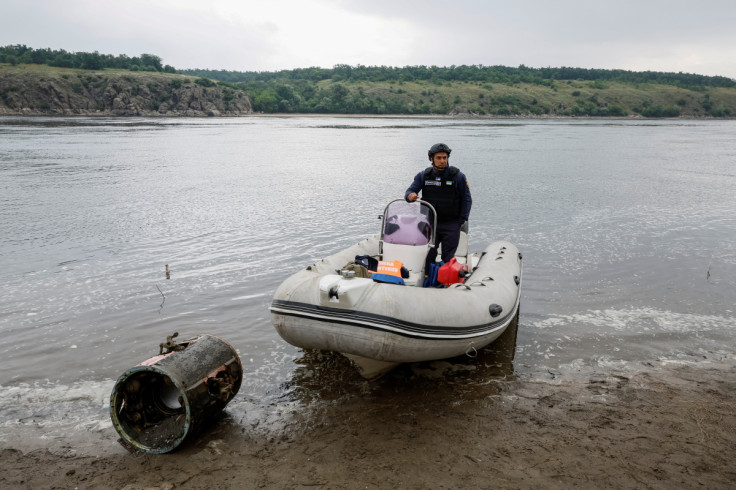Draining Of Ukraine's Kakhovka Reservoir Offers A Reminder Of Past And Present Wars

The draining of one of Europe's largest reservoirs as a result of the destruction of the Kakhovka dam has revealed submerged military objects that offer a reminder of wars past and present on Ukrainian soil.
On a drizzly morning near the southern city of Zaporizhzhia, a team of divers and underwater demining experts from Ukraine's State Emergency service grappled on Monday with the steering element of a S-300 missile. It had fallen in the water since Russia's full-scale invasion and was caked in algae and soil.
The missile fragment had been spotted in shallow water on Saturday by a local resident taking a stroll on the newly formed beach. The demining team's leader, Oleksandr Chechko, said the water level at the location had fallen by around four metres.
He said the amount of explosive or dangerous items the unit had been called out to deal with had grown several times since the Kakhovka dam was destroyed last Monday.
Ukraine's environment minister said the Kakhovka reservoir, which was the body of water contained by the dam, had lost nearly three-quarters of its volume.
Before the disaster, the reservoir contained 18 cubic kilometres (4.3 cubic miles) of water.
Each side blames the other for the dam's destruction last week, but evidence is growing that there was an explosion at the dam around the time it collapsed, according to Ukrainian and U.S. intelligence reports and seismic data from Norway. Russia was in control of the dam when it was destroyed.
The S-300, used by both Russia and Ukraine, is a Soviet-era missile built to intercept aerial targets, such as larger missiles. Russia also uses modified S-300s to hit ground targets in Ukraine. It was not clear which side had launched the recovered missile.
REMNANTS OF A PAST WAR
Chechko said the explosive detritus from the war with Russia was not the only thing exposed by the lower water level, as the dam's destruction had exposed reminders of earlier wars.
"We often recover remnants of S-300 rockets, remnants of Smerch rockets, and after the water (level) fell we are finding munitions from World War Two," he said.
Ukrainian news agency UNIAN posted a video on Sunday showing human remains on the dried-up reservoir bed which it said were from World War Two. One of the decomposing skulls was wearing a helmet similar to those worn by Nazi Germany's soldiers.
Much of southern Ukraine, including the area around the drained reservoir, saw vicious battles in World War Two between the Soviet and German armies. Ukraine says 8 million of its people were killed in that war, a significant part of the Soviet Union's total losses.
The destruction of the Kakhovka dam has provided other historical echoes: In 1941, retreating Soviet forces blew up Zaporizhzhia's huge Dnipro Dam to slow a German assault.
© Copyright Thomson Reuters 2024. All rights reserved.





















